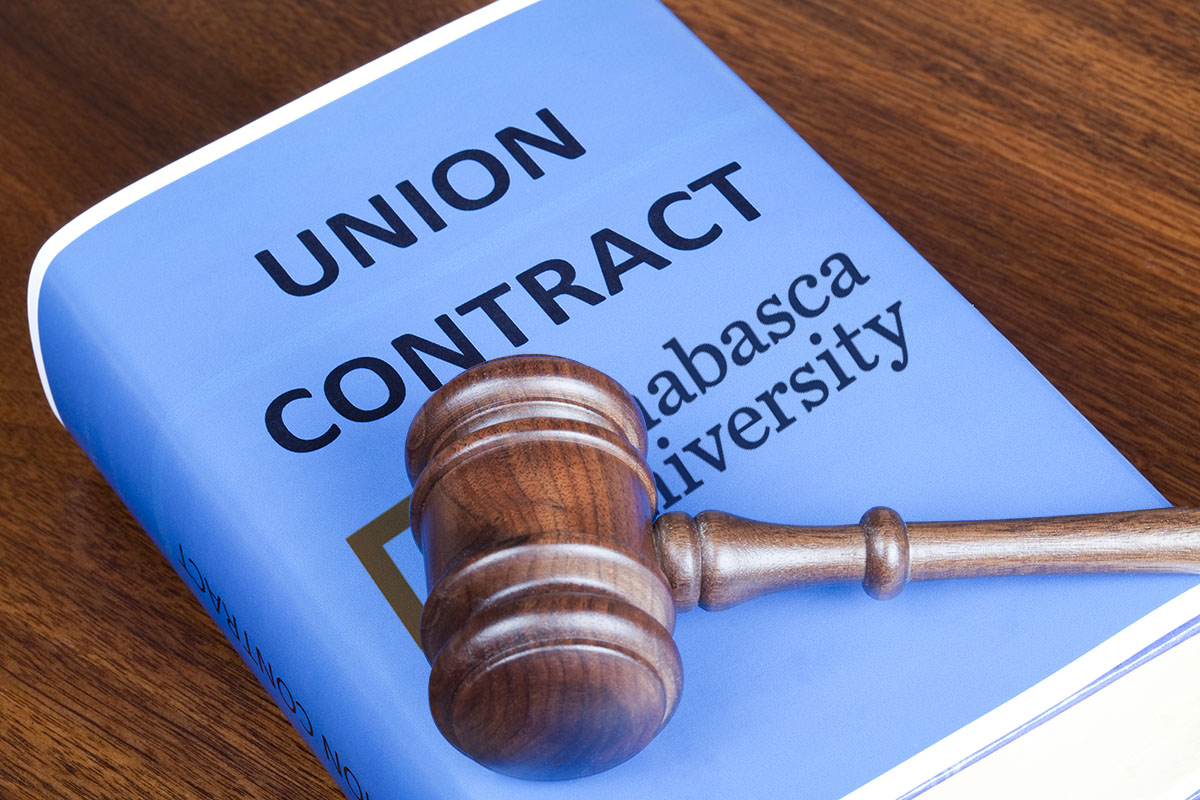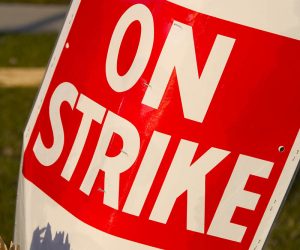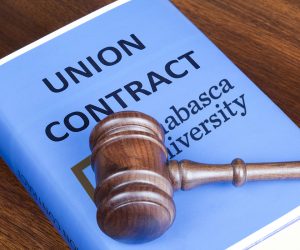 Contract talks at Athabasca University have been ongoing for several months. However, most of the AU student community is unaware these talks are taking place and is also unaware of what they entail. They are between AU and AU’s teaching faculty and professional staff, which include the IT staff, librarians, university relations, and the registrar’s office. The collective agreement that covers the faculty and professional staff outlines the terms and conditions of work, including matters such as hiring, firing, wages, vacations and how to handle disputes. The current agreement ended June 30, 2018 but continues to operate while AU and the AU Faculty Association (AUFA) negotiate a new agreement.
Contract talks at Athabasca University have been ongoing for several months. However, most of the AU student community is unaware these talks are taking place and is also unaware of what they entail. They are between AU and AU’s teaching faculty and professional staff, which include the IT staff, librarians, university relations, and the registrar’s office. The collective agreement that covers the faculty and professional staff outlines the terms and conditions of work, including matters such as hiring, firing, wages, vacations and how to handle disputes. The current agreement ended June 30, 2018 but continues to operate while AU and the AU Faculty Association (AUFA) negotiate a new agreement.
There are two other unions at AU; the Alberta Union of Provincial Employees (AUPE) represents support staff, and the Canadian Union of Provincial Employees (CUPE) represents tutors and academic experts. CUPE recently settled a new agreement, and AUPE contract talks are ongoing.
In the past, when AU and AUFA negotiated and could not come to agreement, the matter was referred to arbitration. A neutral third party, the arbitrator, would look at the offers and decide which would be incorporated into the new agreement.
According to Dr. Bob Barnetson, AU’s Labour Relations professor who has been heavily involved in several contract negotiations at AU over the years, AUFA has had its offer—not AU’s—chosen by the arbitrator as the more reasonable offer the last three times that contract talks reached arbitration.
In 2017, the government changed Alberta’s labour laws in response to a Supreme Court ruling on the freedom to associate. One change is that any bargaining impasse between AUFA and AU is now normally resolved through strike and lockout.
For those who are not familiar with what happens with aspects of union negotiations, a strike is when workers refuse to come to work to pressure the employer to accept the union’s offer. On the other hand, a lockout is when the employer says workers cannot work (and so won’t get paid) to pressure the workers to accept the employer’s offer. It is possible to have either a strike or a lockout or both a strike and lockout at the same time, but it is a difficult and complex dynamic to explain.
Dr. Barnetson told The Voice that collective bargaining between AUFA and AU has been going on since late April, before the current contract expired, but talks have not progressed to the point of finding a resolution and ratifying a new contract. AUFA is seeking a small wage increase, mostly to offset inflation, as well as better protection of professionals’ freedom of expression, a spousal hiring clause, and reducing the use of contract workers.
However, Dr. Barnetson said that AU is seeking a two-year wage freeze and roll backs such as appeal committees being stacked in favour of the employer (which is AU), the elimination of most professional freedom protections, and new provision which will give the employer the ability to send sick members to company doctors for assessment. He notes that these proposals are viewed by the faculty as provocative, especially since AU’s revenues are up and the university is in a healthier position now than it has been. Dr. Barnetson said that AU’s attempt to weaponize sick leave is particularly contentious because of the underlying implication of questioning when and why employees take time off work and setting limits on sick leave.
Dr. Barnetson notes that the current status of contract talks is that bargaining has gone on throughout the summer and is not producing any real results. AUFA’s assessment is that AU is stalling in the expectation that AUFA won’t strike and will eventually cave in. Other settlements with contracts in the public sector are two years of zero wage increases but improvements in the language within the contracts, according to Dr. Barnetson. He notes that these other contract examples should form a template for a contract settlement deal at AU but he says that finding a settlement resolution seems to be difficult because of what he calls “totally unrealistic wage freezes and major language rollbacks.”
To get bargaining moving, AUFA members are engaging in “days of action,” such as hallway posters and social media postings. This is designed to attach costs, mostly reputational and social, to the employers stalling on finding a resolution. As the costs to AU escalate, the Faculty Association hopes to pressure AU to negotiate instead of the “surface bargaining” or going through the motions, that Dr. Barnetson says they have been engaged in up until now. He notes that “So far we’ve been pretty polite and low key about this.”
The Voice also reached out to AU President Dr. Neil Fassina and asked about his perspective on negotiations. In a lengthy emailed response to The Voice’s questions, President Fassina says that:
“The bargaining process is progressing as AU had anticipated. The University has designated a bargaining team and has given them a mandate and the full authority to make decisions on behalf of the University. I can speak with confidence in describing the University’s team as willing and empowered to negotiate fairly, transparently, and in good faith on all issues at the table. To this end, the University’s team continues to approach each session of bargaining well prepared and proactive in adapting and amending the University’s proposals during each bargaining session. The University has been fully transparent about its in-going proposal and the rationale behind each item. So much so that the University shared its proposal early in the bargaining process. In all cases, the University has put forward proposals that it believes are in the best interest of the members of the Faculty Association and the University, but more than anything in the best interest of our learners.”
Dr. Fassina also says that “[Voice] Readers should know that the bargaining environment is different now than it has been in Alberta’s history. The introduction of Bill 7 in 2017 created an environment in which a strike or lockout is a possible. As a result, it is anticipated that this would weigh heavily on the minds and shoulders of all members of the bargaining team.”
The Voice asked Dr. Fassina about whether the current political climate in Alberta, as well as the distance learning format of Athabasca University, has any bearing on the negotiation process. Dr Fassina said that “I do not believe that our Open environment has a direct impact on the bargaining environment other than recognizing that some of the things the University and Faculty Association talk about in bargaining might be different than you might expect in a place-based university environment. AU is thankful for the support given to us by Minister Schmidt and the other members of the Government and Alberta Public Service toward our very positive future. With each step and decision, the University endeavors to allocate the resources provided to it by the Province and through student tuition in the most effective and supportive way possible toward achieving learners’ personal goals.”
Dr. Jolene Armstrong, who is president of the AUFA, and a key negotiator, echoed this sentiment. “I’m not sure about the distributed workplace necessarily being a barrier to effective bargaining, but since this is the first time bargaining under the new legislation, I guess we’ll find out. I think that over the past few years, AUFA has worked very hard to cement the solidarity of the membership, and more recently members have really come out in support of its bargaining team. It’s an exciting time, as we’re basically inventing how to collectively bargain in a brand new lockout/strike regime in a distributed work force. There really aren’t many models to look to. I think there’s a tendency to feel rather singled out in terms of the various pressures that faculty face at AU. But then you attend other labour conferences and you talk to people from across Canada and you realize that the pressure and challenges we are facing are pretty much universal.”
Dr. Armstrong also felt optimistic about the current political climate in Alberta, which affects university funding, but noted that AU will take time to recover from years of post-secondary cutbacks. “I think that the funding troubles that we are experiencing are due to a legacy of unstable, unpredictable funding under forty years of conservative governments. The cuts were brutal, and the damage is still felt today. I don’t think institutions ever really recovered, even when things became more stable. So many people were laid off, and worse than that was the inability of institutions to be able to plan because the funding was so unpredictable. The last couple of years under the NDP have been a bit of a relief, but it will take many more years of stable and incremental funding increases to recover what has been lost due to those bad years. AU has unique challenges dues to its heavy reliance on IT, and the fact that a larger proportion of our students are from out of province and, to date, no government has been willing to address these funding challenges that are specific to AU despite numerous attempts on the part of the university administrations to find a sympathetic ear and convince the government to address what amounts to a pretty serious inequity in the funding for AU.”
For those who don’t know, what Dr. Armstrong is talking about is how the Alberta government allocates funding to universities in part based on how many Alberta students that university serves. The government does not provide funding for out of province students, but rather allows post-secondary institutions to charge whatever fees they feel appropriate. However, AU has, in the past, felt that increasing these fees to the full cost of delivering the course would make them uncompetitive.
While Dr. Fassina is unable to discuss specifics about the process, citing confidentiality and respect for negotiating in good faith, he wishes to highlight that “the current negotiations have given me and other members of the University’s leadership team a chance to continue demonstrating our willingness to be as transparent as possible as we respond to many of the tough questions that come out of bargaining. As we transform our university for the betterment of learners and society overall, transparency is and will continue to be paramount.”
Dr. Barnetson said that at present, bargaining is continuing and there is no talk of a strike or a lockout. If there is no resolution to contract negotiations, eventually there will be an impasse where further bargaining is pointless. The worst-case scenario for the AU community is that a strike or lockout takes place. This would affect employees but would also trickle down to students as many AU services require AUFA members to function. The process of a work stoppage is laborious and only occurs after all avenues of mediation and negotiation are exhausted and a strike vote and notice to strike are issued. Dr. Fassina noted that in the unlikely event that negotiations are not successful in creating a mutually agreeable result, the Labour Code provides for the potential for a strike or a lockout. In either of these cases, the University would go out of its way to continue supporting students in their learning journey. Before either a strike or a lockout could take place, there is a series of steps that must be taken by each of the parties involved.
Dr. Armstrong also hopes it doesn’t come to that [a strike or lockout], and says that AU’s faculty bargaining team is working very hard to achieve a fair agreement.
But if a work stoppage should occur, will students be affected? “In the short term, yes. But in the long term, they will benefit from the types of gains, or protections that faculty might be willing to walk over—consider that if a labour dispute occurs, it will be over something really serious, and often over protecting core academic values or about attempts to improve working conditions that have degenerated so badly that it is difficult for effective teaching and research to take place. I think that what needs to be avoided at all costs are wedges between bargaining units, and this includes the students’ unions. After all, the faculty’s teaching conditions are the students’ learning conditions. How close are we to a labour dispute at AU? Without a crystal ball, it’s hard to say, so while things have not been going particularly well at the table, there is still a lot of time left, and anything can happen that would bring the parties to an agreement.”
Dr. Fassina’s response was also optimistic about the outcome. “While the worst case is difficult to define due to the complexity of the bargaining process and potential outcomes, is important to highlight that the University continues to approach bargaining proactively, transparently, and willing to find a mutually agreeable settlement in the best interest of the students, the faculty association, and the university. Given our current context, I do not see us moving toward a work stoppage.”
How can AU students show their support for the teaching faculty and other university staff who are engaged in contract negotiations? Dr. Armstrong said “We would love to hear from the students’ unions and create opportunities for discussion and support. I think it’s too easy to say that the staff’s concerns are divergent from the students’ concerns, but I think that is an oversimplification of the issue. I think students do care about the working conditions of their professors, tutors, and the professional staff that provide various supports for students. I think that they do care about the kind of institution that they are earning a degree from. I think that once the students connect to the idea that if faculty are being treated poorly, or if academic principles are being compromised, then their learning is compromised, the students will see that that has a direct effect on their learning goals. I think it could be empowering to students to support the learning environment that their professors work within, and this includes the many professional staff who work tirelessly behind the scenes.
Dr. Fassina also gave his assurances to students by saying “The best perspective I can provide is to be patient during what is a fairly typical bargaining process. Moreover, integral to the University’s commitment to transparency is the premise of responding to facts and not rumours; therefore, the University is committed to open and honest communication within the confines of the collective bargaining process. Therefore, if learners hear rumors or facts that are concerning, feel free to connect with the University and we can seek to confirm, clarify or dispel any information floating around.”
The latest update to the bargaining process from Dr. Barnetson is that bargaining has gone on for five months and the teams have met for 10 or so days of bargaining and, in his words, “There has been basically no progress.” He goes on to say that every other public sector agreement is coming in with two years of wage freezes, a wage re-opener for year three, and language improvements for the workers. AU continues to offer a two-year freeze and massive language roll backs, which are unacceptable to AUFA members. If there is to be a work stoppage, the likely timeline for it would probably be next spring (April or May) which reflects the necessary steps to get to that point and is also during the next provincial election.
The Voice hopes to provide updates to this story as they occur.


